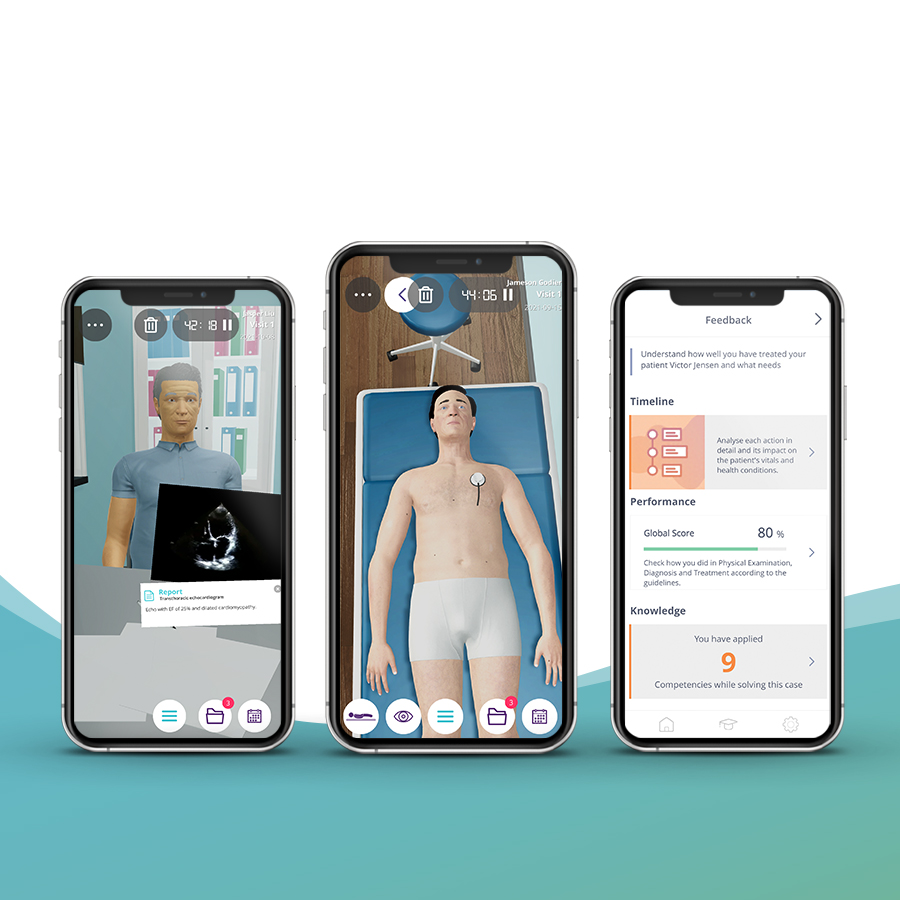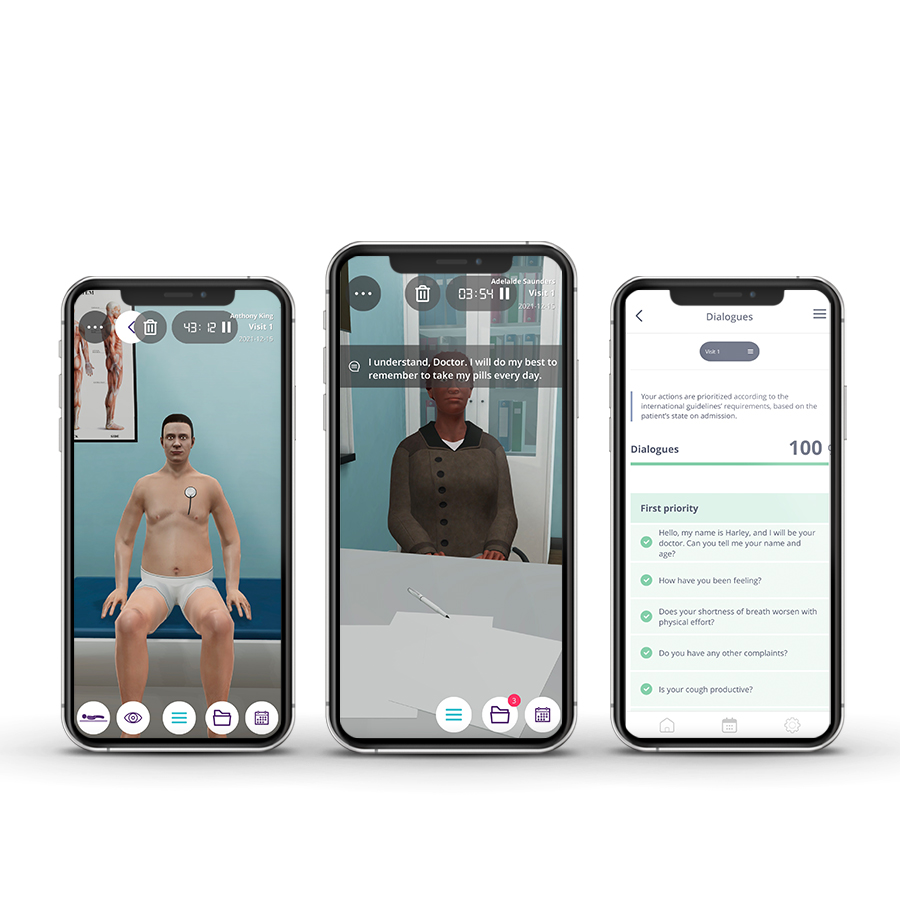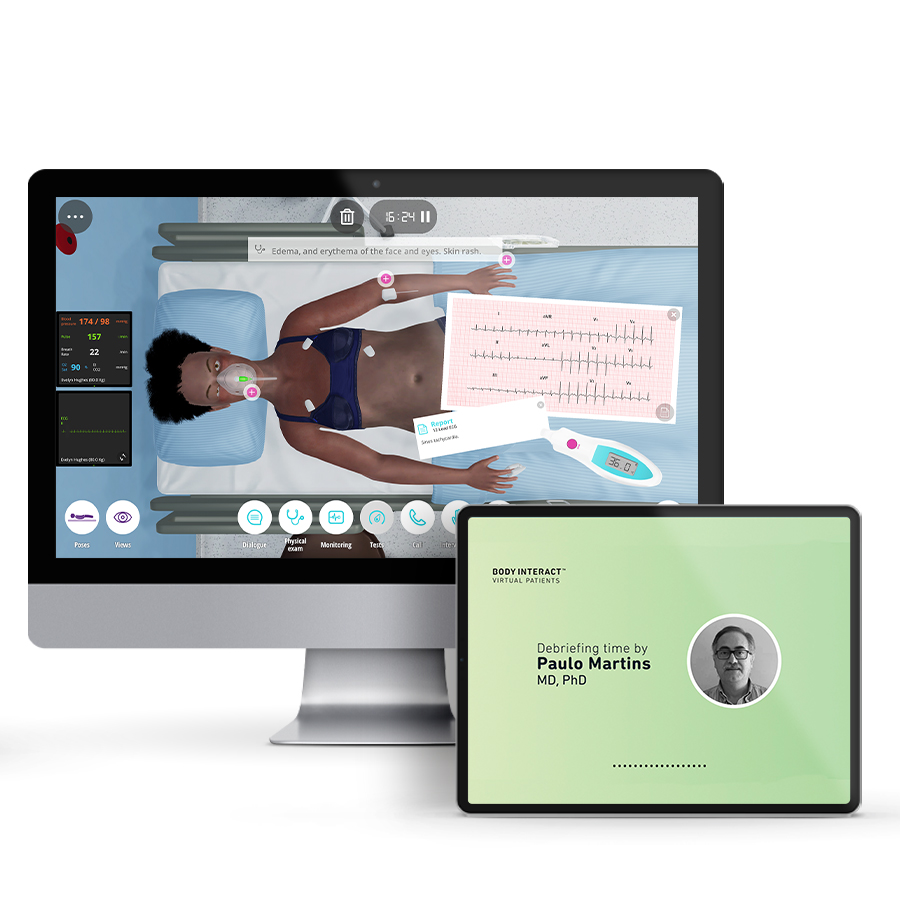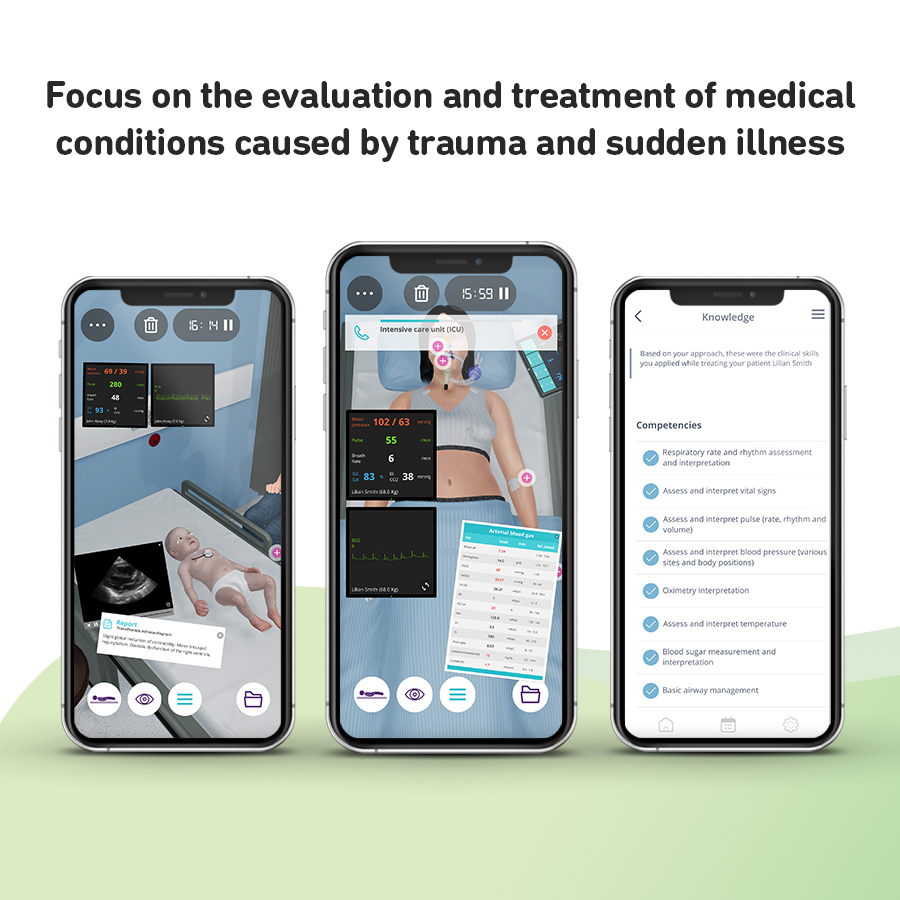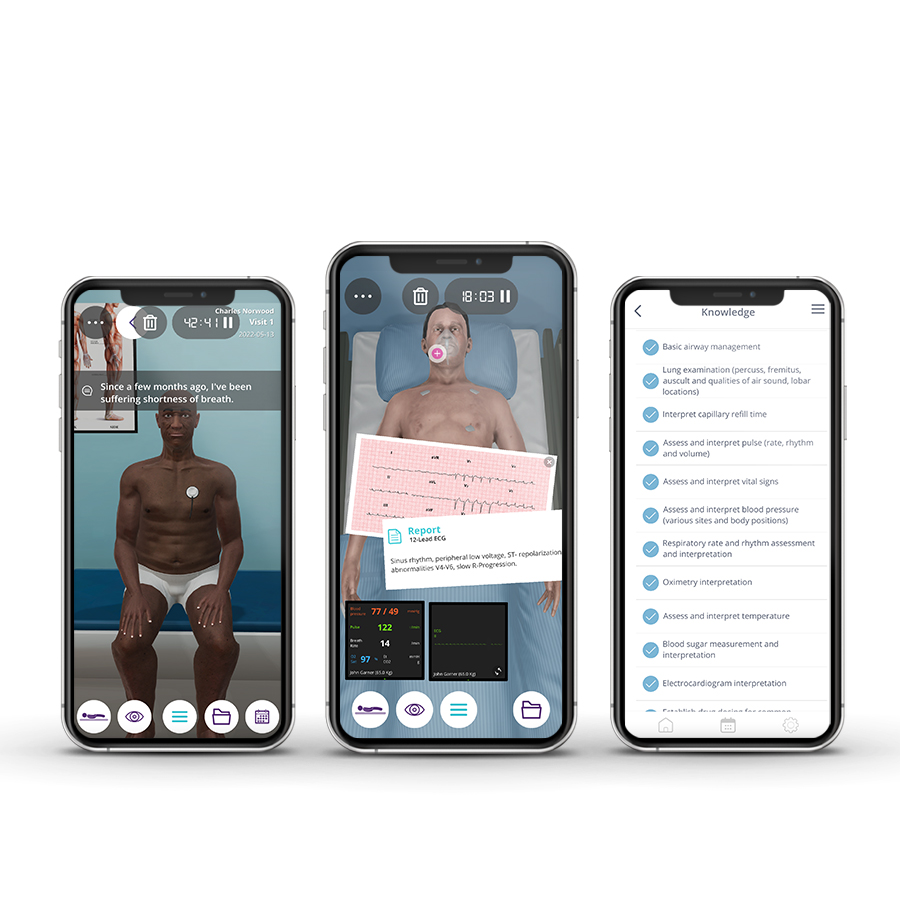Description
Course type: Online; Self-Paced
Specialty: Specialty: Cardiology / Endocrinology
Language: English, Portuguese
Resources: Debriefing Videos
Level: Intermediate / Advanced
Target: General Practitioner and Hospital Care Physicians
Modules: 10
Durations: 2 months
Time Effort: Up to 110 minutes per module
Certificate: Yes
Course Description
SHIELD (Simulation of High-risk patients for Empowerment, Learning, and Disease Management) is an innovative and interactive training program that explores the primary and hospital care physicians’ role in cardiovascular risk and diabetes management. This practice-based activity provides an update on the latest guidelines and novel approaches to global cardiovascular protection.
The SHIELD course allows to educate primary and hospital care physicians and on current evidence-based treatment goals and most recent clinical management recommendations for high-risk cardiovascular and diabetic patients.
Course Overview
- 10 Modules
• 10 virtual patient cases of an intermediate level of complexity - Average Time to practice (per module):
• Clinical Scenario: 20 minutes per attempt (3 attempts: 60 minutes)
• Final attempt (if applicable): 20 minutes
• Multiple Choice Question: 5 minutes
• Feedback Area: 10 minutes
• Learning Objectives and Scientific References: 10 minutes
• Debriefing Video: 10 minutes - Online, Self-paced
• You have up to 2 months to complete the 10 modules at your own pace. The course can be accessed through Body Interact at any time. - Certificate of Completion
• After completing the course, you will receive a Certificate of Completion that can be added to your CV or Resume.
Learning Objectives
• Understand the role of SLT2 inhibitors in the treatment and cardioprotection of diabetic, cardiac insufficiency, and renal insufficiency patients.
• Optimize the estimation of cardiovascular risk in diabetic patients with cardiac insufficiency and renal insufficiency and promote its reduction using the best available pharmacological therapy
• Identify and manage potential side effects of cardioprotective medication in these patient populations
Clinical Competencies
Safety
• Collect patients clinical information
• Detect heart murmurs
Airway and Breathing
• Lung examination (percuss, fremitus, auscult and qualities of air sound, lobar locations)
• Oximetry interpretation
• Respiratory rate and rhythm assessment and interpretation
• Thorax examination (shape, movement, diameter, ribs and diaphragm)
Circulation
• Assess and interpret blood pressure (various sites and body positions)
• Assess and interpret pulse (rate, rhythm and volume)
• Assess and interpret vital signs
• Detect heart murmurs
• Identify S1 heart sounds (tricuspid, mitral) and S2 (pulmonary, aortic) heart sounds and detect
Disability
• Blood sugar measurement and interpretation
Exposure
• Abdominal plain x-ray interpretation
• Assess and interpret temperature
• Assess height and weight
• Cardiac enzyme interpretation
• Chest x-ray interpretation
• Consultation management
• Electrocardiogram interpretation
• Fluid/Electrolyte test interpretation
• Hand and foot examination
• Hematocrit interpretation
• Lipid test interpretation
• Liver function test interpretation
• Nuclear imaging techniques interpretation
• Nutrition management
• Refer to healthcare/ medical specialties
• Renal function test interpretation
• Ultrasonography interpretation
• Urinalysis interpretation
• Utilize medical records
• Write prescriptions (including controlled drug)
Module 1 – A routine appointment with some lab abnormalities
Context: More than a metabolic disease, diabetes is an important cardiovascular risk factor with a very adverse prognostic impact. Throughout its natural history, it is important to simultaneously optimize antibiotic and cardioprotective therapy and identify and control all cardiovascular risk factors. When diagnosing diabetes, starting cardioprotective antidiabetic therapy is vital to ensure the best possible prognosis.
Virtual Scenario: Mr. Joshua has been struggling to stop smoking for over 10 years and has also a past medical history of hypertension and dyslipidemia.
Module 2 – Routine appointment with complaints of fatigue when doing hard work
Context: More than a metabolic disease, diabetes is an important cardiovascular risk factor with a very adverse prognostic impact. Throughout its natural history, it is important to simultaneously optimize antibiotic and cardioprotective therapy and identify and control all cardiovascular risk factors. When monotherapy is not enough, it is important to choose the best cardioprotective antidiabetic therapy.
Virtual Scenario: Ms. Voight has a medical history of type 2 diabetes, hypertension, and dyslipidemia.
Module 3 – Is normal is always normal?
Context: More than a metabolic disease, diabetes is an important cardiovascular risk factor with a very adverse prognostic impact. Throughout its natural history, it is important to simultaneously optimize antibiotic and cardioprotective therapy and identify and control all cardiovascular risk factors. When dual therapy is not enough, it is important to reinforce it with the best cardioprotective antidiabetic therapy.
Virtual Scenario: Mr. Godier was diagnosed with diabetes eight years ago. Since then, he is regularly visiting a doctor to check his health.
Module 4 – When three is to many but not enough
Context: More than a metabolic disease, diabetes is an important cardiovascular risk factor with a very adverse prognostic impact. Throughout its natural history, it is important to simultaneously optimize antibiotic and cardioprotective therapy and identify and control all cardiovascular risk factors. Even in patients already insulin-treated, whenever metabolic control is not perfect, it makes sense to consider a reinforcement of oral cardioprotective therapy.
Virtual Scenario: Mrs. Hudson is retired and loves to take care of her grandchildren during the week. She has had diabetes for over 11 years but she has never managed to control her sugar levels. Additionally, she has hypertension and dyslipidemia.
Module 5 – A patient with de novo fatigue and dyspnea
Context: The new ESC guidelines represent a change of paradigm in the treatment of heart failure, which now has four pillars regarding drug therapy. In each heart failure patient, our goal is now to introduce these four drugs in the optimal doses as soon as possible to improve patient prognosis. This means adding a SGLT2 inhibitor in all patients eligible.
Virtual Scenario: Mr. Liu has recently retired from his job. He has been losing his energy with small efforts at home, going up and down the stairs. He has also a medical history of alcoholism and smoking.
Module 6 – I keep getting tired and short of breath. Can you help me?
Context: The new ESC guidelines represent a change of paradigm in the treatment of heart failure, which now has four pillars regarding drug therapy. In each heart failure patient, our goal is now to introduce these four drugs in the optimal doses as soon as possible to improve patient prognosis. In many heart failure patients, conventional therapy will not be enough, thus requiring new optimal therapy.
Virtual Scenario: Ms. Wilkins hasn’t been feeling well lately. Daily tasks seem to leave her without any energy, even before completing them. A family member recommended she see a doctor, which is why she is here at the clinic.
Module 7 – I take several meds but I keep feeling tired. What’s wrong with me?
Context: The new ESC guidelines represent a change of paradigm in the treatment of heart failure, which now has four pillars regarding drug therapy. In each heart failure patient, our goal is now to introduce these four drugs in the optimal doses as soon as possible to improve patient prognosis. In many heart failure patients, triple therapy will not be enough, thus requiring the fourth pillar.
Virtual Scenario: Mr. Reed really enjoys socializing with his friends. He has dinner with his friends every week, but at his last dinner, his colleagues noticed that he felt very tired and with shortness of breath when he made small efforts. They talked to him and he made a routine appointment.
Module 8 – Swollen eyes and orange urine
Context: Recent studies promote a change of paradigm in the treatment of kidney failure, which now has three pillars regarding drug therapy. In each kidney failure patient, our goal is now to introduce these drugs in the optimal doses as soon as possible to improve patient prognosis. It should be done as soon as a diagnosis of kidney failure is done.
Virtual Scenario: Mr. Akiyama was progressively urinating less during the past couple of years. At first, he didn’t notice anything odd with the frequency he went to the bathroom. However, as this situation progressed, he couldn’t ignore the problem anymore and scheduled a visit at the clinic.
Module 9 – Kidneys and Pancreas: a deadly duet
Context: Recent studies promote a change of paradigm in the treatment of kidney failure, which now has three pillars regarding drug therapy. In each kidney failure patient, our goal is now to introduce these drugs in the optimal doses as soon as possible to improve patient prognosis. One of these drugs can be used not only for kidney protection but also for cardiovascular and metabolic optimization
Virtual Scenario: Ms. Kamau has had diabetes for several years. Unfortunately, she has not paid much attention to the doctor’s advice, which has not helped control her blood glucose levels. Lately, she has been feeling ill and decided to see her doctor.
Module 10 – If salt can kill you, can sugar save you?
Context: Recent studies promote a change of paradigm in the treatment of kidney failure, which now has three pillars regarding drug therapy. In each kidney failure patient, our goal is now to introduce these drugs in the optimal doses as soon as possible to improve patient prognosis. In patients using only classical therapy, the adding of a third drug can vastly improve kidney function and patient prognosis.
Virtual Scenario: Mr. Alexandersson is a senior with a tendency for high blood pressure. He has felt that his health is not as robust as it used to be, so he reluctantly accepted his wife’s insistence to see a doctor.
Authors and Speakers
With a multidisciplinary group of international clinical reviewers, Body Interact ensures a high standard of accuracy, diversity, and impact of its course.
Pedro Monteiro
MD, PhD
Faculty of Medicine, University of Coimbra, Portugal
Cardiology Consultant – Coimbra University Hospital
Scientific References
- C. Thomas M. Type 2 Diabetes and Heart Failure: Challenges and Solutions. Current Cardiology Reviews. 2016;12(3):249-255.
- Clark WF, Huang S-H, Garg AX, et al. The Chronic Kidney Disease Water Intake Trial: Protocol of a Randomized Controlled Trial. Canadian Journal of Kidney Health and Disease. 2017;4:2054358117725106.
- Cosentino F, Grant PJ, Aboyans V, et al. 2019 ESC Guidelines on diabetes, pre-diabetes, and cardiovascular diseases developed in collaboration with the EASD: The Task Force for diabetes, pre-diabetes, and cardiovascular diseases of the European Society of Cardiology (ESC) and the European Association for the Study of Diabetes (EASD). European Heart Journal. 2020;41(2):255-323.
- Dunlay Shannon M., Givertz Michael M., Aguilar David, et al. Type 2 Diabetes Mellitus and Heart Failure: A Scientific Statement From the American Heart Association and the Heart Failure Society of America: This statement does not represent an update of the 2017 ACC/AHA/HFSA heart failure guideline update. Circulation. 2019;140(7):e294-e324.
- Grundy Scott M., Stone Neil J., Bailey Alison L., et al. 2018 AHA/ACC/AACVPR/AAPA/ABC/ACPM/ADA/AGS/APhA/ASPC/NLA/PCNA Guideline on the Management of Blood Cholesterol: A Report of the American College of Cardiology/American Heart Association Task Force on Clinical Practice Guidelines. Circulation. 2019;139(25):e1082-e1143.
- Kato Eri T., Silverman Michael G., Mosenzon Ofri, et al. Effect of Dapagliflozin on Heart Failure and Mortality in Type 2 Diabetes Mellitus. Circulation. 2019;139(22):2528-2536.
- Ko GJ, Obi Y, Tortoricci AR, Kalantar-Zadeh K. Dietary Protein Intake and Chronic Kidney Disease. Current opinion in clinical nutrition and metabolic care. 2017;20(1):77-85.
- Lee L. Nutrition and the African-American diet. Sampson Independent. Published February 10, 2018. Accessed August 13, 2021. https://www.clintonnc.com/features/lifestyle/27515/nutrition-and-the-african-american-diet
- McDonagh TA, Metra M, Adamo M, et al. 2021 ESC Guidelines for the diagnosis and treatment of acute and chronic heart failure: Developed by the Task Force for the diagnosis and treatment of acute and chronic heart failure of the European Society of Cardiology (ESC) With the special contribution of the Heart Failure Association (HFA) of the ESC. European Heart Journal. 2021;42(36):3599-3726.
- Radholm K, Figtree G, Perkovic V, et al. Canagliflozin and Heart Failure in Type 2 Diabetes Mellitus: Results From the CANVAS Program. Circulation. 2018;138(5):458-468.
- Unnikrishnan AG, Kalra S, Purandare V, Vasnawala H. Genital Infections with Sodium Glucose Cotransporter-2 Inhibitors: Occurrence and Management in Patients with Type 2 Diabetes Mellitus. Indian Journal of Endocrinology and Metabolism. 2018;22(6):837-842.
- Whelton PK, Carey RM, Aronow WS, et al. 2017 ACC/AHA/AAPA/ABC/ACPM/AGS/APhA/ASH/ASPC/NMA/PCNA Guideline for the Prevention, Detection, Evaluation, and Management of High Blood Pressure in Adults: Executive Summary: A Report of the American College of Cardiology/American Heart Association Task Force on Clinical Practice Guidelines. Hypertension (Dallas, Tex: 1979). 2018;71(6):1269-1324.
- Williams B, Mancia G, Spiering W, et al. 2018 ESC/ESH Guidelines for the management of arterial hypertension: The Task Force for the management of arterial hypertension of the European Society of Cardiology (ESC) and the European Society of Hypertension (ESH). European Heart Journal. 2018;39(33):3021-3104.
- Yancy Clyde W., Jessup Mariell, Bozkurt Biykem, et al. 2017 ACC/AHA/HFSA Focused Update of the 2013 ACCF/AHA Guideline for the Management of Heart Failure. Journal of the American College of Cardiology. 2017;70(6):776-803.
- Zelniker TA, Wiviott SD, Raz I, et al. SGLT2 inhibitors for primary and secondary prevention of cardiovascular and renal outcomes in type 2 diabetes: a systematic review and meta-analysis of cardiovascular outcome trials. The Lancet. 2019;393(10166):31-39.


